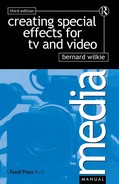Stop-Frame Film Animation
This the technique used in the making of animated puppet films and commercials in which inanimate objects appear to move. Manipulated by hand, the subjects are fractionally re-positioned before each frame of the film is exposed. Computer-generated animation, although now in common use, has not replaced the stop-frame film technique which, to some, has a more pleasing quality.
Technique
Before commencing filming, it is advisable to make a chart of the movements required. Normal film projection is at 24 frames a second and all movement is consequently related to this yardstick.
Each movement is first assessed in real time. Say, for example, that a cigarette pack is required to spin at the rate of one revolution a second. This rotation has to be calculated on the basis that the pack revolves once in 24 separate movements.
In practice, if the movement is too small, it is possible to shoot two or more frames of each position.
Slow movements look realistic, but fast ones often appear jerky.
Puppet construction
Puppets are usually made from flexible material modelled on aluminium wire armatures. They should be ‘dead’ with no trace of springiness. During animation it should be possible to pin their feet to the baseboard so that one limb is always firmly located. Hours of patient filming can be ruined if a puppet shifts accidently during animation.
Life-sized animation
The animation of full-sized objects is commonplace in the making of certain TV commercials in which people rush around at high speed, food dances on tables and delighted women clean their kitchens in a flash. In the case of inanimate objects it is simply a matter of moving the items, exposing one frame of film, moving them again and so on. But there are things to look out for. In the recording of a long sequence outdoors, the light can change as clouds pass overhead, operators can flatten grass (which causes it to wave violently) and while moving to and fro may inadvertently move something else. Any of these can render hours of work unusable.
Nightmare Spider
With a body of lightweight expanded polystyrene and legs of stiff wire covered in latex and paper tissues, this spider can be animated to move realistically. However, unless the movements or a real spider are studied and copied, the results will look artificial. (This task can be made easier by using a camcorder.)

